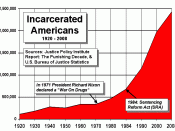Prison overcrowding is a major problem in our criminal justice system and it continues to be a hotly debated topic as to how we should address the problem. One of the main reasons our prison systems have a problem with overcrowding is drugs. More specifically, the "war on drugs" started by President Reagan in 1982 brought a dramatic increase to the number of people put behind bars for drug offences. Mandatory minimum sentencing and truth in sentencing are two policies which have sent drug offenders to prison and kept them there for longer periods of time. The continuing crusade against drugs has apprehended hundreds of thousands of suspects who spend millions on drugs but the cost to incarcerate these non-violent offenders exceeds billions of dollars and much of that money is coming from the taxpayers' pockets. One way to address this problem is to reverse the current trend of putting first time, non-violent drug offenders in prison and instead sentence these offenders to boot camp and counselling combined with family support.
There are currently over two million people in our nation's state and federal prisons and jails. Nearly one and a half million of these offenders occupy state and federal prisons, serving over a year in detention for felonies.(1) The most alarming statistic is the fact that the United States houses twenty five percent of the world's inmates. A good percentage of these convicts are serving time for drug crimes, most of which are first time, non-violent offenders. Every year, many prisons throughout the country scramble to find appropriate housing for these extra prisoners, many of whom are there as a result of the mandatory minimum laws passed throughout the federal and state legislatures. By 1983, forty states had enacted some type of mandatory minimum sentencing act and in 1986...


